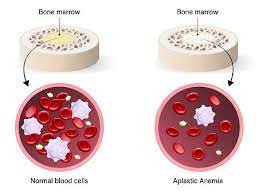Definisi
Anemia aplastik adalah suatu kondisi di mana tubuh Anda berhenti memproduksi sel darah merah baru yang cukup. Terjadi gangguan pada sel punca di dalam sumsum tulang yang memengaruhi produksi sel darah. Sumsum tulang adalah jaringan lunak pada pusat tulang yang berperan dalam menghasilkan sel darah dan keping darah (trombosit).
Gangguan darah ini tergolong langka dan bersifat serius, serta bisa muncul pada usia berapapun. Anemia aplastik bisa membuat Anda lebih rentan mengalami infeksi dan perdarahan yang tidak terkontrol. Penyakit ini dapat muncul mendadak, atau bisa berkembang secara perlahan dan memburuk seiring perjalanan waktu.
Kami juga memiliki artikel mengenai anemia yang bisa Anda baca di sini.
Penyebab
Sel punca di dalam sumsum tulang memproduksi sel darah yang meliputi sel darah merah, sel darah putih, dan keping darah. Terjadi kerusakan sel punca pada anemia aplastik, sehingga terjadi penurunan kadar jenis-jenis sel darah ini di tubuh. Sebagai akibatnya, bisa ditemukan tidak ada darah (aplastik) atau hanya ada sedikit sel darah (hipoplastik) dalam sumsum tulang.
Pada banyak kasus, dokter tidak dapat mengidentifikasi penyebab anemia aplastik. Namun ada beberapa hal yang sudah diketahui bisa mencederai sumsum tulang dan memengaruhi produksi sel darah, yaitu:
- Terapi radiasi dan kemoterapi
Walaupun pengobatan radiasi dan kemoterapi bermanfaat dalam membunuh sel kanker, namun pengobata juga bisa memengaruhi sel sehat seperti sel punca pada sumsum tulang. Anemia aplastik bisa timbul sebagai efek samping sementara dari terapi tersebut.
- Paparan terhadap bahan kimia beracun
Zat kimia seperti beberapa bahan yang digunakan dalam pestisida dan insektisida telah dikaitkan dengan anemia aplastik. Senyawa kimia lain yaitu benzena, suatu bahan untuk bensin, juga dikaitkan dengan penyakit ini. Anemia aplastik bisa membaik jika Anda menghindari paparan berulang terhadap bahan kimia penyebab anemia.
- Penggunaan obat-obatan tertentu
Ada beberapa obat yang dikaitkan dengan anemia aplastik, seperti antibiotik kloramfenikol dan golongan sulfonamid, obat antinyeri dan peradangan pada artritis rheumatoid, atau obat antitiroid.
- Penyakit autoimun
Penyebab tersering dari anemia aplastik adalah gangguan autoimun, di mana sistem kekebalan tubuh turut menyerang sel tubuh yang sehat. Contohnya, sistem imun tubuh berusaha menghancurkan sel punca pada sumsum tulang sehingga terjadi anemia aplastik.
- Infeksi virus
Infeksi akibat virus Epstein-Barr, sitomegalovirus, HIV, atau parvovirus B19 telah dikaitkan dengan perkembangan anemia aplastik.
- Kehamilan
Sistem kekebalan tubuh Anda dapat menyerang sumsum tulang Anda selama kehamilan. Diduga hal ini ada kaitannya dengan hormon estrogen yang membuat volume plasma meningkat lebih banyak dari laju produksi sel darah merah. Namun mekanisme dan penyebab pasti dari hal ini masih belum diketahui.
- Anemia Fanconi
Anemia Fanconi adalah penyakit keturunan yang langka dan bisa menyebabkan anemia aplastik. Anak yang lahir dengan anemia Fanconi cenderung lebih kecil dan memiliki gangguan bawaan lahir, seperti anggota gerak yang kurang berkembang. Penyakit ini dapat didiagnosis dengan bantuan pemeriksaan darah.
Faktor Risiko
Anemia aplastik adalah penyakit yang jarang ditemukan. Faktor yang dapat meningkatkan risiko dari munculnya penyakit ini antara lain:
- Pasien kanker yang sedang menjalani terapi radiasi atau kemoterapi dosis tinggi.
- Sering terpapar dengan zat atau senyawa kimia beracun.
- Memiliki penyakit radang sendi rheumatoid arthritis atau gangguan tiroid dan sedang dalam pengobatan.
- Menderita gangguan darah, penyakit autoimun atau infeksi serius tertentu.
- Kehamilan bisa meningkatkan risiko terjadinya anemia, walaupun jarang wanita hamil ditemukan menderita anemia aplastik.
Gejala
Pasien anemia aplastik bisa tidak menunjukkan gejala sama sekali. Umumnya keluhan yang muncul dikaitkan dengan kurangnya sel darah merah, seperti:
- Kelelahan dan kelemahan tubuh
- Detak jantung cepat atau tidak teratur
- Sesak napas
- Kulit pucat
- Mudah terinfeksi atau infeksi terjadi berkepanjangan
- Mudah memar atau memar timbul tanpa sebab yang jelas
- Mimisan dan gusi berdarah
- Perdarahan yang sulit berhenti, misalnya dari luka
- Ruam kulit
- Pusing
- Nyeri kepala
- Demam
Diagnosis
Dokter akan bertanya mengenai keluhan Anda secara mendetail, yang bisa dilanjutkan dengan riwayat penyakit Anda dan keluarga, serta pengobatan yang sedang dijalani. Selain melakukan pemeriksaan fisik, pada pasien anemia diperlukan pemeriksaan penunjang untuk mengetahui kadar darah pasien lebih lanjut.
Pemeriksaan di bawah ini dapat membantu dalam diagnosis anemia aplastik, yaitu:
- Pemeriksaan darah
Normalnya kadar sel darah merah, sel darah putih, dan keping darah berada dalam suatu rentang tertentu yang normal. Pada anemia aplastik, bisa ditemukan kadar yang rendah dari ketiga sel darah ini.
-
- Kadar sel darah merah atau hemoglobin rendah (anemia)
- Kadar sel darah merah imatur atau retikulosit rendah
- Kadar sel darah putih atau leukosit rendah (leukopenia)
- Kadar keping darah atau trombosit rendah (trombositopenia)
- Biopsi sumsum tulang
Pada pemeriksaan ini, dokter akan memakai jarum untuk mengambil sedikit sampel dari sumsum tulang di tubuh. Sampel bisa diambil dari tulang besar di tubuh. Sampel akan dibawa ke laboratorium untuk diperiksa di bawah mikroskop. Pada anemia aplastik, ditemukan sel darah yang lebih sedikit dari normal di sumsum tulang dan peningkatan lemak. Konfirmasi diagnosis anemia aplastik membutuhkan biopsi sumsum tulang
Tata Laksana
Pengobatan yang diberikan untuk pasien anemia aplastik akan bergantung pada tingkat keparahan kondisi dan usia pasien. Pengobatan bisa meliputi:
Transfusi Darah
Meskipun tidak dapat menyembuhkan anemia aplastik, transfusi darah dapat mengontrol perdarahan dan memperbaiki gejala. Pasien akan ditransfusikan sel darah yang tidak diproduksi oleh sumsum tulangnya. Bila Anda menerima diagnosis anemia aplastik, Anda dapat menerima transfusi sel darah merah atau keping darah.
Meskipun umumnya tidak ada batasan jumlah transfusi darah yang dapat Anda terima, namun terkadang bisa muncul komplikasi seiring banyaknya transfusi yang diterima. Pada transfusi sel darah merah, besi yang diterima bisa menumpuk di tubuh dan merusak organ penting di tubuh jika kondisi kelebihan besi tersebut tidak diatasi.
Seiring waktu, pengobatan dengan transfusi bisa menjadi kurang efektif dalam mengatasi gejala anemia aplastik. Hal ini karena tubuh bisa menghasilkan antibodi terhadap darah yang ditransfusikan. Akan jadi kondisi yang membahayakan nyawa bila kadar sel darah menjadi sangat rendah. Penggunaan obat penekan sistem imun akan menurunkan kemungkinan terjadinya komplikasi ini.
Transplantasi Sel Punca
Transplantasi sel punca atau sumsum tulang adalah pilihan pengobatan yang disarankan pada pasien dengan anemia aplastik berat. Terapi ini bisa menjadi pengobatan yang direkomendasikan pada orang-orang yang berusia di bawah 50 tahun. Pengobatan ini bisa bekerja dengan baik bila pasien memiliki donor yang cocok sepenuhnya, seperti saudara kandung.
Jika donor ditemukan, Anda bisa menerima terapi radiasi atau kemoterapi terlebih dahulu. Kemudian, sel punca yang sehat dari donor akan disaring dari darah. Sel punca sehat akan disuntikan ke dalam pembuluh darah vena yang kemudian berjalan menuju sumsum tulang, dan mulai memproduksi sel darah baru.
Setelah transplantasi sel punca, Anda akan menerima pengobatan untuk mencgah terjadinya reaksi penolakan dari tubuh terhadap sel punca yang didonorkan.
Pengobatan
Untuk orang yang tidak dapat menjalani transplantasi sumsum tulang atau pada anemia aplastik akibat penyakit autoimun, pasien bisa diberikan obat penekan sistem kekebalan tubuh (obat imunosupresan). Diharapkan sumsum tulang bisa pulih dan menghasilkan sel darah baru. Selain itu, beberapa obat tertentu juga bisa membantu menstimulasi sumsum tulang untuk menghasilkan sel darah baru.
Menderita anemia aplastik akan melemahkan sistem kekebalan tubuh, yang menyebabkan Anda lebih rentan terhadap infeksi. Jika Anda mengalami anemia aplastik berat, antibiotik atau antivirus bisa diberikan untuk membantu mencegah infeksi. Seluruh pengobatan Anda akan diawasi oleh dokter.
Komplikasi
Anemia aplastik dapat menyebabkan masalah lain seperti sering infeksi dan perdarahan. Anda juga akan mengalami peningkatan risiko mengalami kelainan darah yang serius. Jika tidak ditangani, anemia aplastik juga bisa menyebabkan penyakit jantung seperti aritmia (gangguan irama jantung), pembesaran jantung, atau gagal jantung.
Pencegahan
Karena banyak kasus anemia aplastik tidak diketahui penyebabnya, sulit untuk mengetahui langkah pasti dalam mencegah anemia aplastik. Mengenai pengobatan atau penyakit yang bisa meningkatkan risiko terjadinya anemia aplastik, konsultasikan lebih lanjut mengenai penyakit dan pengobatan Anda dengan dokter.
Anda juga bisa menghindari paparan terhadap insektisida, herbisida, pelarut organik, penghapus cat, dan bahan kimia beracun lainnya yang dapat menurunkan risiko Anda mengalami anemia aplasitk.
Kapan Harus ke Dokter?
Hubungi dokter atau kunjungi instalasi gawat darurat jika terjadi perdarahan tanpa penyebab atau jika perdarahan sulit berhenti. Hubungi dokter jika Anda mengalami infeksi yang seringa tau kelelahan yang tidak biasanya.
Mau tahu informasi seputar penyakit lainnya? Cek di sini, ya!
- dr Hanifa Rahma
Aplastic anemia (2022) Mayo Clinic. Mayo Foundation for Medical Education and Research. Available at: https://www.mayoclinic.org/diseases-conditions/aplastic-anemia/symptoms-causes/syc-20355015 (Accessed: March 7, 2023).
Aplastic anemia (2022) MedlinePlus. U.S. National Library of Medicine. Available at: https://medlineplus.gov/aplasticanemia.html (Accessed: March 7, 2023).
Aplastic anemia (no date) Mount Sinai Health System. Available at: https://www.mountsinai.org/health-library/diseases-conditions/aplastic-anemia (Accessed: March 7, 2023).












